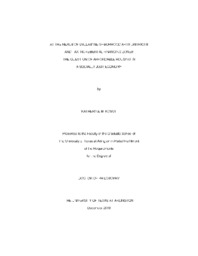
ATTENTION: The works hosted here are being migrated to a new repository that will consolidate resources, improve discoverability, and better show UTA's research impact on the global community. We will update authors as the migration progresses. Please see MavMatrix for more information.
Show simple item record
| dc.contributor.advisor | Arvidson, Enid | |
| dc.creator | Kosut, Katherine M. | |
| dc.date.accessioned | 2022-07-14T12:32:29Z | |
| dc.date.available | 2022-07-14T12:32:29Z | |
| dc.date.created | 2019-12 | |
| dc.date.issued | 2019-12-06 | |
| dc.date.submitted | December 2019 | |
| dc.identifier.uri | http://hdl.handle.net/10106/30666 | |
| dc.description.abstract | This dissertation examines the effects of urban economic development policies on affordable housing and the resident working-class populations within neighborhood arts district (NAD) and the Tax Incremental Financing (TIF) support of the NAD revitalization. This study questions whether municipally endorsed “creative gentrification” in the form of the tax-based economic development policy—tax incremental financing—increases the effects of gentrification and housing affordability loss in low-income neighborhood arts districts in the United States, using Dallas TX as a case study. Historically intended to provide fit-housing in low-income “blighted” neighborhoods, States have adopted TIF policies in reliance upon the concept that “but-for” the use of the TIF policy, there would be no remedy to the “blight” within these community. The controversial TIF policies enacted and utilized by municipalities to shift public tax dollars from other non-municipal entities (e.g., school districts) have met with varying degrees of economic development success by municipal local administrative standards. However, TIFs capitalizing upon the synergies of culturally rich but resource- poor communities within neighborhoods arts districts has resulted in larger tax capture.
Concomitant with this largermore significant tax capture is evidence of incumbent population displacement, gentrification, and loss of housing affordability—reinforcing an economic process of commodification of housing, power and exploitation, creating inequality and injustice. Gentrification and government’s Arts Based Economic Development and value-capture taxation policies can be viewed as assisting investors to makein making profit within NAD-TIFs while creating housing affordability issues for the incumbent working class. Alternative housing networks (AHNs) have appeared as hybrids of Community Economies Collectives and diverse economies, challenging the neoliberal political economy as a co-existing possibility for more sustainable urban revitalization.
Based on the theories of geographer Neil Smith and economist Henry George, the reform of land ownership that AHNs can bring into NAD-TIFs is more than a theoretical challenge. It has implications for capital’s ability to access local neighborhoods and exploit the real estate within NADs for their exchange value. Ideally separating land from the speculative market as the regime’s financial investment limits their ability of total control of the local scale of neighborhoods in order to realize a return. As an alternative to the municipal regime’s eminent powers, viewing themselves simultaneously as advocates, activist, and radicals—alternative housing networks (AHNs) are one of the “other possibilities,” co-existing and providing alternative community control of land and housing. More than a model for affordable housing, ANHs could potentially be a foundation for a new set of economic relationships that promote the claims of local communities over those of capital. AHNs can be a platform for affordable housing, but also a movement towards a more socially just economy. | |
| dc.format.mimetype | application/pdf | |
| dc.subject | Affordability | |
| dc.subject | Economic Development | |
| dc.subject | Gentrification | |
| dc.subject | Tax Policy | |
| dc.title | At the Nexus of Dallas' Neighborhood Arts Districts and Tax Incremental Financing Zones: the Question of Affordable Housing in a Socially Just Economy | |
| dc.type | Thesis | |
| dc.date.updated | 2022-07-14T12:32:29Z | |
| thesis.degree.department | Urban and Public Affairs | |
| thesis.degree.grantor | The University of Texas at Arlington | |
| thesis.degree.level | Doctoral | |
| thesis.degree.name | Doctor of Philosophy in Urban Planning and Public Policy | |
| dc.type.material | text | |
| dc.creator.orcid | 0000-0003-1210-1776 | |
Files in this item
- Name:
- KOSUT-DISSERTATION-2019.pdf
- Size:
- 78.58Mb
- Format:
- PDF
This item appears in the following Collection(s)
Show simple item record


